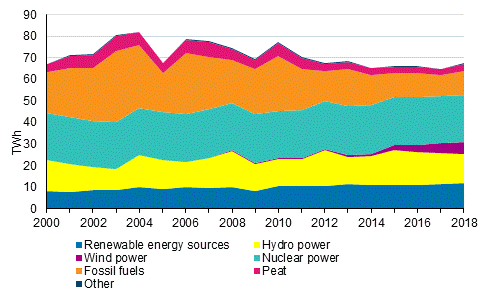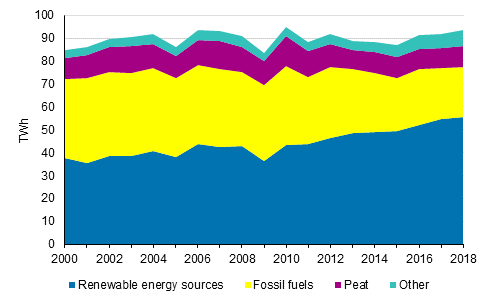Published: 1 November 2019
The amount of electricity produced with fossil fuels and peat grew by 14 per cent in 2018 - The share of renewable energy sources in electricity production decreased
The production of electricity in Finland amounted to 67.5 TWh in 2018, which was 2.5 TWh more than in the year before. The amount of electricity produced with renewable energy sources and nuclear energy only increased slightly, but 1.7 TWh more electricity than in 2017 was produced with fossil fuels and peat. Now 46.2 per cent of electricity was produced with renewable energy sources while in 2017, the share was 47.2 per cent. The production of district heat increased slightly (0.5%) but the production of industrial heat grew by as much as 3.2 per cent. The use of fossil fuels in the production of district and industrial heat remained almost unchanged, but the use of peat increased by seven per cent and that of renewable energy sources by 2.1 per cent. In all, 53 per cent of district heat was produced with fossil fuels and peat, but in industrial heat the share of renewables was 75 per cent. These data derive from the statistics on the production of electricity and heat compiled by Statistics Finland.
Electricity generation by energy source 2000-2018

In 2018, the production of electricity in Finland amounted to 67.5 terawatt hours (TWh) or one billion kilowatt hours (kWh). Production grew by 2.5 TWh from the previous year. Correspondingly, total consumption of electricity went up by 2.0 TWh amounting to 87.5 TWh in 2018. Of total electricity consumption, 77 per cent was covered by domestic production and 23 per cent by net imports of electricity from the Nordic countries, Russia and Estonia. Net imports of electricity contracted by 2.4 per cent from the year before. Thirty-two per cent of domestic electricity production was based on combined heat and power production.
The volume of electricity produced with renewable energy sources amounted to 31.2 TWh. Renewable energy sources accounted for 46 per cent of electricity production. Of the electricity produced with renewable energy sources 42 per cent was produced with hydro power, 19 per cent with wind power and almost all of the remainder with wood-based fuels. Thirty-two per cent of electricity was produced with nuclear power, 16 per cent with fossil fuels and five per cent with peat.
The electricity produced by hydro power amounted to 13.1 TWh, which is clearly less than in the year before. The share of hydro power in electricity production varies yearly according to the water situation. The amount of electricity produced with renewable energy sources grew slightly in 2018 despite the fact that the amount of electricity produced with hydro power decreased by ten per cent. The growth in the total amount of electricity produced with renewable energy sources was largely caused by wind power production, which grew by 22 per cent. The amount of electricity produced with wood-based fuels also increased clearly (7%).
The amount of electricity produced with fossil fuels increased by 11 per cent and that of electricity produced with peat by as much as 25 per cent from 2017. The amount of electricity produced with hard coal declined somewhat but, correspondingly, clearly more electricity than in 2017 was produced with other fossil fuels, especially with natural gas in 2018.
The upturn in manufacturing was visible as an increase in electricity (and industrial heat) production. This, together with lower availability of hydro-power, was visible as an increase in the use of fossil fuels and peat, as well as an increase in separate production of electricity that is clearly less efficient than combined production. A majority of the growth in electricity produced with fuels was caused by the increase in separate production of electricity with fossil fuels and peat (1.1 TWh). The remainder of the increase in electricity produced with fuels was divided quite evenly between combined production with fossil fuels and peat (0.7 TWh) as well as separate (0.5 TWh) and combined (0.4 TWh) production with renewable fuels. Among renewable fuels only the amount of electricity produced with black liquor (wood-based black liquor from the forest industry) increased clearly.
Electricity and heat production and fuels used by production mode in 2018
| Electricity, GWh | District heat, GWh | Industrial heat, GWh | Fuels used, TJ 1) | |
| Separate production of electricity | ||||
| - Hydro power | 13 137 | .. | .. | .. |
| - Wind power | 5 839 | .. | .. | .. |
| - Solar power | 90 | .. | .. | .. |
| - Nuclear power | 21 881 | .. | .. | .. |
| - Condensing power 2) | 4 748 | .. | .. | 50 510 |
| - Total | 45 695 | .. | .. | 50 510 |
| Combined heat and power production | 21 836 | 24 709 | 43 539 | 402 261 |
| Separate heat production | .. | 13 800 | 11 665 | 92 033 |
| Total production | 67 532 | 38 509 | 55 204 | 544 804 |
| Net imports of electricity | 19 936 | .. | .. | .. |
| Total | 87 467 | 38 509 | 55 204 | 544 804 |
2) Condensing power includes condensing power plants, shares of condensing electricity of combined heat and power production plants, and peak gas turbines and similar separate electricity production plants.
The production of district heat totalled 38.5 TWh in 2018, being 0.5 per cent higher than in the previous year. The use of renewable and fossil fuels in the production of district heat remained unchanged, but the use of peat increased by seven per cent from the year before. Clearly under one-half of district heat was produced with fossil fuels. Most of district heat was produced with wood fuels (33%) and hard coal (20 %). Peat retained its position as the third most important energy source in district heat production; 15 per cent of district heat was produced with peat. The amount of district heat produced with flue gas scrubbers and other waste heat (includes heat pumps) has grown considerably in recent years. They produced nine per cent of district heat in 2018.
The production of industrial heat was 55.2 TWh in 2018. Production went up 3.2 per cent from the year before. One-half of heat produced for the needs of manufacturing comes from black liquor. In all, 75 per cent of the production of industrial heat was based on renewable fuels. One of the biggest users of industrial heat is the forest industry, which uses its own fuels in production, like black liquor and other wood fuels. In the chemical and metal industries, part of the use of heat is considered as direct fuel use, and is thus not visible in the production figures on heat.
District heat and industrial heat production by fuels 2000-2018

The statistics on the production of electricity and heat cover the entire production of electricity connected to the grid. The coverage of the statistics has been improved by adding district heat production plants. Therefore, the figures are not fully comparable with the statistics for previous years. Solar power and small CHP produced with biogas are also included in the statistics. From 2015 onwards, the statistics also cover small heat plants, that is, all production of district heat. The statistics do not cover all industrial heat and producers of so-called local heating.
Links:
Statistics Finland's inquiry on production of electricity and heat
Finnish Energy Industries, electricity production statistics https://energia.fi/en/news_and_publications/statistics
Source: Statistics on production of electricity and heat, Statistics Finland and Electricity statistics, Finnish Energy Industries
Inquiries: Pekka Lösönen 029 551 3268, Minna Niininen 029 551 3549, energia@stat.fi
Director in charge: Ville Vertanen
Publication in pdf-format (363.6 kB)
- Tables
-
Tables in databases
Pick the data you need into tables, view the data as graphs, or download the data for your use.
Appendix tables
- Figures
-
- Appendix figure 1. Electricity generation by energy source 2018 (1.11.2019)
- Appendix figure 2. Electricity generation with renewables 2018 (1.11.2019)
- Appendix figure 3. Electricity generation by production mode 2000-2018 (1.11.2019)
- Appendix figure 4. Electricity generation with renewables 2000-2018 (1.11.2019)
- Appendix figure 5. District heat production by fuels 2000-2018 (1.11.2019)
- Appendix figure 6. Industrial heat production by fuels 2000-2018 (1.11.2019)
- Appendix figure 7. Fuel use in separate electricity production 2017-2018 (1.11.2019)
- Appendix figure 8. Fuel use in combined heat and power production 2017-2018 (1.11.2019)
- Appendix figure 9. Fuel use in separate heat production 2017-2018 (1.11.2019)
Updated 1.11.2019
Official Statistics of Finland (OSF):
Production of electricity and heat [e-publication].
ISSN=1798-5099. 2018. Helsinki: Statistics Finland [referred: 20.4.2025].
Access method: http://stat.fi/til/salatuo/2018/salatuo_2018_2019-11-01_tie_001_en.html

